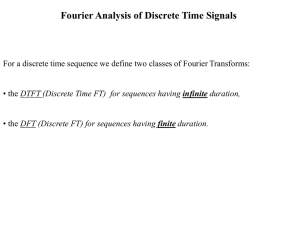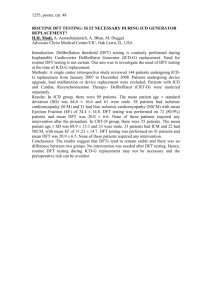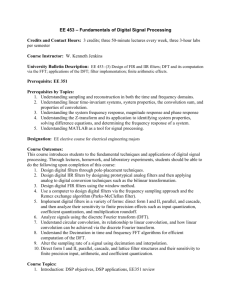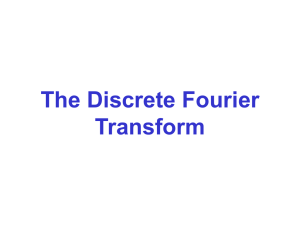DSP-UNIT-II - VRS College of Engineering & Technology
advertisement
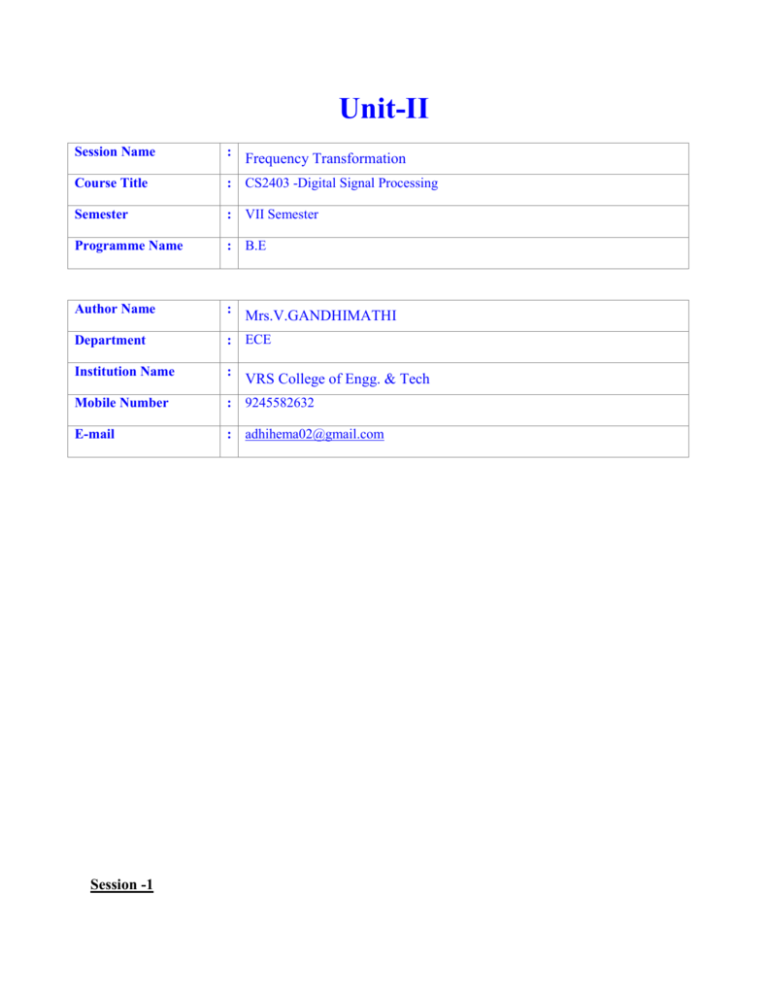
Unit-II
Session Name
:
Course Title
: CS2403 -Digital Signal Processing
Semester
: VII Semester
Programme Name
: B.E
Author Name
:
Department
: ECE
Institution Name
:
Mobile Number
: 9245582632
E-mail
: adhihema02@gmail.com
Session -1
Frequency Transformation
Mrs.V.GANDHIMATHI
VRS College of Engg. & Tech
1. Introduction: Discrete Fourier Transform
Since the learners have some basic understanding about Fourier transform, it would be a
good idea to ask some basic questions to help the learners recall the concepts DFT.
http://en.wikipedia.org/wiki/Discrete_Fourier_transform
Introduction to DFT
In mathematics, the discrete Fourier transform (DFT) converts a finite list of equally
spaced samples of a function into the list of coefficients of a finite combination of complex
sinusoids, ordered by their frequencies, that has those same sample values. It can be said to
convert the sampled function from its original domain (often time or position along a line) to
the frequency domain.
The input samples are complex numbers (in practice, usually real numbers), and the
output coefficients are complex too. The frequencies of the output sinusoids are integer multiples
of a fundamental frequency, whose corresponding period is the length of the sampling interval.
The combination of sinusoids obtained through the DFT is therefore periodic with that same
period. The DFT differs from the discrete-time Fourier transform (DTFT) in that its input and
output sequences are both finite; it is therefore said to be the Fourier analysis of finite-domain (or
periodic) discrete-time functions.
The DFT is the most important discrete transform, used to perform Fourier analysis in
many practical applications. In digital signal processing, the function is any quantity
or signal that varies over time, such as the pressure of a sound wave, a radio signal, or daily
temperature readings, sampled over a finite time interval (often defined by a window function).
In image processing, the samples can be the values of pixels along a row or column of a raster
image. The DFT is also used to efficiently solve partial differential equations, and to perform
other operations such as convolutions or multiplying large integers.
Since it deals with a finite amount of data, it can be implemented
in computers by numerical algorithms or even dedicated hardware. These implementations
usually employ efficient fast Fourier transform (FFT) algorithms;[1] so much so that the terms
"FFT" and "DFT" are often used interchangeably. The terminology is further blurred by the (now
rare) synonym finite Fourier transform for the DFT, which apparently predates the term "fast
Fourier transform" but has the same initialism.
Suggested Activity: Introduces & Questions
Questions
a.
b.
c.
d.
Define Fourier.
Write the formula for Fourier transform.
Define IFT.
Differentiate FT for CT and DT signals.
1. DFT and IDFT
http://www.dspguide.com/ch8/2.htm
Suggested Activity: Explains and Problems
The DFT and IDFT can be explained on the board .Write the formula for DFT and IDFT
and solve problems using formulas.
3. Conclusion –Mind map
a. Define DFT and IDFT.
b. Give the formulas for DFT and IDFT
c. Determine DFT for x (n) = {1,1,0,0}
The frequency domain contains exactly the same information as the time domain, just in
a different form. If you know one domain, you can calculate the other. Given the time domain
signal,
the process
of calculating the frequency domain is
called decomposition,
analysis, the forward DFT, or simply, the DFT. If you know the frequency domain, calculation
of the time domain is called synthesis, or the inverse DFT. Both synthesis and analysis can be
represented in equation form and computer algorithm.The number of samples in the time domain
is usually represented by the variable N. While N can be any positive integer, a power of two is
usually chosen, i.e., 128, 256, 512, 1024, etc. There are two reasons for this. First, digital data
storage uses binary addressing, making powers of two a natural signal length. Second, the most
efficient algorithm for calculating the DFT, the Fast Fourier Transform (FFT), usually operates
with N that is a power of two. Typically, N is selected between 32 and 4096. In most cases, the
samples run from 0 to N-1, rather than 1 to N.
Session -2
1. Recap: DFT
Suggested Activity: Quiz
We can conduct a quiz to check the learners what things they learned in previous
session.
2. Properties of DFT
http://en.wikipedia.org/wiki/Discrete_Fourier_transform
Suggested Activity: Chalk and talk, PPT
Periodicity, Linearity
Time & frequency shifting
Time reversal of a sequence
Periodicity
If the expression that defines the DFT is evaluated for all integers k instead of just for
then the resulting infinite sequence is a periodic extension of the DFT, periodic with period N.
,
The periodicity can be shown directly from the definition:
Similarly, it
DF
T
Another way of looking at the DFT is to note that in the above discussion, the DFT can be expressed as
a Vandermonde matrix:
where
is a primitive Nth root of unity. The inverse transform is then given by the inverse of the above matrix:
With unitary normalization constants
matrix:
3. Conclusion :
Suggested Activity: Chart
, the DFT becomes a unitary transformation, defined by a unitary
Session-3
1. Recap: DFT
Suggested Activity: Recall
DFT concepts can be recall by using DFT and IDFT formulas
2. Properties of DFT
Suggested Activity: Presentation, chalk and talk
3. Conclusion and summary:
Suggested Activity: Word Puzzles
Words:
a. DFT
b. IDFT
c. Periodicity
d. Linear
e. Time shift
f. Frequency shift
Session-4
1.Filtering methods based on DFT
Suggested Activity: Introduces
https://engineering.purdue.edu/~ee538/DFTbasedLinearFiltering.pdf
2. Overlap save and add method
Suggested Activity: chalk and talk
We can explain overlap and save method on the board
3. Conclusion and summary:
Suggested Activity: Problems solved
Example:
x(n)={ 1,-1,2,-2,3,-3,4,-4} and h(n) ={-1,1}
Session-5
1. Introduction – FFT Algorithms
Suggested Activity: Introduces
2. Radix-2 and Radix-4 algorithms
Suggested Activity: Writing board
3. Conclusion:
Suggested Activity: Rapid fire
1. Define FFT.
2. Compare DFT and FFT
3. Advantages of FFT.
Session -6
1. Decimation in time Algorithms:
Suggested Activity: Introduces
FFT Algorithm Decimation-in-time-Algorithm
Decimation-in- Time FFT Algorithms To achieve the dramatic ...
2. DIT-Procedure
Suggested Activity: Writing board
3. Conclusion:
Suggested Activity: Formulas
Session -7
1. Decimation in frequency Algorithms:
Suggested Activity: Introduces
The radix-2 decimation-in-frequency algorithm rearranges the discrete Fourier transform
(DFT) equation into two parts: computation of the even-numbered discrete-frequency
indices X(k) for k=[0,2,4,…,N−2] (or X(2r) and computation of the odd-numbered
indices k=[1,3,5,…,N−1] (or X(2r+1) )
X(2r)=∑n=0N−1x(n)W2rnN∑n=0N2−1x(n)W2rnN+∑n=0N2−1x(n+N2)W2r(n+N2)N∑n=0N2−
1x(n)W2rnN+∑n=0N2−1x(n+N2)W2rnN1∑n=0N2−1(x(n)+x(n+N2))WrnN2DFTN2[x(n)+x(n+
N2)]
X(2r+1)=∑n=0N−1x(n)W(2r+1)nN∑n=0N2−1(x(n)+WN2Nx(n+N2))W(2r+1)nN∑n=0N2−1((x(
n)−x(n+N2))WnN)WrnN2DFTN2[(x(n)−x(n+N2))WnN]
The mathematical simplifications reveal that both the even-indexed and odd-indexed
frequency outputs X(k) can each be computed by a length-N2 DFT. The inputs to these DFTs are
sums or differences of the first and second halves of the input signal, respectively, where the
input to the short DFT producing the odd-indexed frequencies is multiplied by a socalled twiddle factor term WkN=e−(i2πkN). This is called decimation in frequency because the
frequency samples are computed separately in alternating groups and a radix-2 algorithm
because there are two groups. . This conversion of the full DFT into a series of shorter DFTs
with a simple preprocessing step gives the decimation-in-frequency FFT its computational
savings.
2. DIT-Procedure
Suggested Activity: chalk and talk
3. Conclusion:
Suggested Activity: Learner led presentation
We can asked to any one of the learner to summarize the DIT and the procedure of DIF
Session -8
1. Introduction-Linear filtering:
Suggested Activity:
Introduces
2. Use of FFT algorithm in linear filtering
Use of FFT in Linear Filtering
A Linear Filtering Approach to the Computation of Discrete Fourier ...
Suggested Activity: presentation
3. Conclusion:
Suggested Activity: Rapid fire
Questions:
a. What is linear filtering?
b. What are the convolution sectioned methods?
c. Differentiate overlap add and save method.
d. Give the procedure for convolution method.
Session -9
1. Introduction-DCT :
Suggested Activity:
Introduces and questions
http://www.cs.cf.ac.uk/Dave/Multimedia/node231.html
2. DCT- Formulas and definitions
Suggested Activity: Chalk and talk
3. Conclusion:
Suggested Activity: Formulas
The Discrete Cosine Transform (DCT)
The discrete cosine transform (DCT) helps separate the image into parts (or
spectral sub-bands) of differing importance (with respect to the image's visual quality). The DCT
is similar to the discrete Fourier transform: it transforms a signal or image from the spatial
domain to the frequency domain (Fig 7.8).
DCT Encoding
The general equation for a 1D (N data items) DCT is defined by the following
equation:
and the corresponding inverse 1D DCT transform is simple F-1(u), i.e.:
where
The general equation for a 2D (N by M image) DCT is defined by the following
equation:
and the corresponding inverse 2D DCT transform is simple F-1(u,v),

